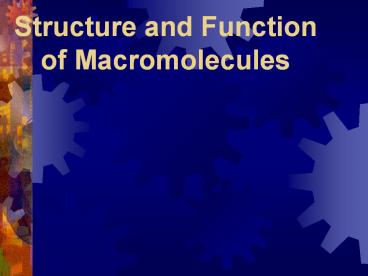Structure and Function of Macromolecules - PowerPoint PPT Presentation
1 / 29
Title:
Structure and Function of Macromolecules
Description:
Structure and Function of Macromolecules. VERSITILE CARBON. Carbon has a valence ... Cellulose and chitin are examples of structural polysaccharides. ... – PowerPoint PPT presentation
Number of Views:887
Avg rating:3.0/5.0
Title: Structure and Function of Macromolecules
1
Structure and Function of Macromolecules
2
VERSITILE CARBON
- Carbon has a valence of 4 which makes it capable
of entering into 4 covalent bonds.
3
Carbon to form many different chemical compounds
- 1). Length of the carbon skeleton may differ (
C-C, C-C-C, C-C-C-C-C, etc.). 2). Branching
of the carbon skeleton - ( C-C-C-C, C-C-C-C-C ) C
4
- 3). The number of double bonds may differ
- ( CC-C-C, CCC-C ).
- 4). The molecular structure may be in ring form.
Chemical compounds with the same molecular
formula but different structural formulas is
called an isomer.
5
- These macromolecules are constructed of smaller
units called polymers. These polymers are
subdivided into their basic units called
monomers.
6
Making and breaking of polymers
7
Dehydration synthesis
- is an anabolic process by which two molecules are
chemically bonded through the use of enzymes and
a loss of water.
8
Hydrolysis
- is a catabolic process by which the bond
between monomers are broken by the enzyme and the
addition of water.
9
Carbohydrates
- The monosaccharide is a monomer, the disaccharide
is a polymer,and the polysaccharides are
macromolecules.
10
Monosaccharides The basic formula (CH2O)
- Examples
- pentose sugars. 5 carbons. ribose, deoxyribose,
and ribulose hexose sugars, 6 carbons, glucose,
galactose, and fructose.
11
Disaccharides These are double sugars with the
formula C11H22O11
12
Polysaccharides
- The basic formula is ( C6H10O5)n . These are
macromolecules capable of acting as structural or
storage molecules.
13
(No Transcript)
14
Structural Polysaccharides Cellulose and chitin
are examples of structural polysaccharides.
15
- Lipids A group of polymers that have one
characteristic in common, they do not mix with
water. They are hydrophobic. Some important
groups are fats, phospholipids, and steroids.
16
- Fats are large molecules composed of 2 types of
monomers, glycerol ( an alcohol containing 3
carbons) and 3 fatty acid molecules.
17
Saturated or Unsaturated?
- Saturated fatty acids do not contain any double
bonds between the carbons, - Unsaturated fatty acids contain one or more
double bonds between the carbons. (Double bonds
cut down on the number of hydrogen atoms that can
be attached to the carbon in the molecule.) This
causes the molecule to bend or kink at each of
the double bond sites.
18
Characteristics of Fats
- SATURATED
- solid at room temperature
- found mostly in animals
- no double bonds between carbons
- UNSATURATED
- liquid at room temperature
- found mostly in plants
- double bonds found between carbons
19
Function of fats
- act as insulation in higher vertebrates, serves
as an energy storage source 1g.9 Kcal of energy,
and shock absorber for internal organs.
20
Phospholipids
- structurally related to fats but contain 2 fatty
acids and one molecule of phosphate. These
molecules are found making up the plasma membrane
of cells. They exhibit a polar and non polar
quality. The phosphate group is hydrophilic while
the fatty acid area is hydrophobic.
21
Steroids
- Lipids characterized by a carbon skeleton of 4
fused rings. Cholesterol is an important steroid
found in all animal tissue. Plants do not contain
cholesterol. Cholesterol functions in many ways
it is a precursor from which many of the bodies
steroids are constructed from. It also adds
strength to the plasma membrane in animal cells.
22
Proteins
- macromolecules that make up 50 of the dry weight
of most cells.
23
Types of proteins
- 1. Structural ( support)
- examples elastin, collagen, and keratin
- 2. Storage food source, examples
- ovalbumin and casein
- 3. Transport moves other substances,
- examples hemoglobin and cell membrane proteins
- Hormonal coordinates bodily activities,
- example insulin,
- 5. Contractile movement,
- examples actin and myosin
- 6. Antibodies defense,
- examples Ig.E, IgA, and Ig.G 7.
- Enzymes aid in chemical reactions,
- examples amylase and proteases
24
Amino Acids
- Most amino acids consist of an asymmetrical
carbon bonded to an, amino group, hydrogen, an R
group,and a carboxyl group.
25
Amino Acids
- Most amino acids consist of an asymmetrical
carbon bonded to an, amino group, hydrogen, an R
group,and a carboxyl group.
26
Protein conformation
- refers to the three dimensional shape of a
protein molecule. This shape is important to its
function. If the conformation is changed, even
slightly , then the function of the protein
changes.
27
Nucleic Acids ( DNA and RNA)
- Nucleotides monomers that come together to form
a nucleic acid. They contain either a ribose or
deoxyribose sugar ( ribose has one more oxygen in
its molecule), a phosphate and a nitrogen base
28
DNA Base pairing rules.
29
DNA






























